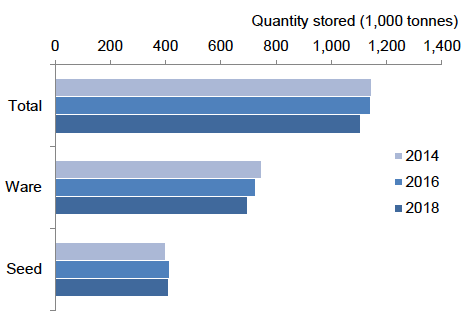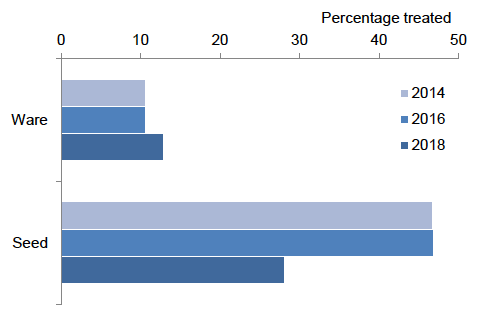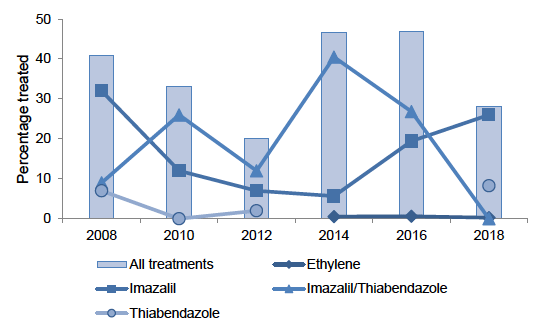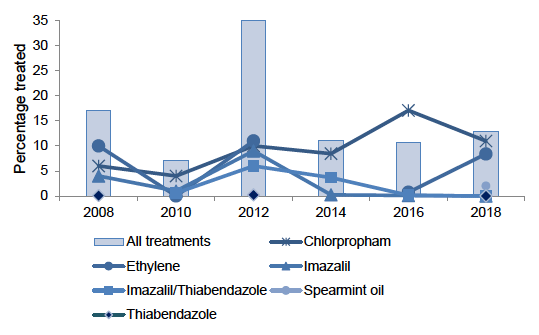Pesticide usage - arable crops and potato stores 2018: survey results
Information from a survey of pesticide use on arable crops and potato stores in Scotland during 2018.
General trends
Scottish potato storage
The total estimated quantity of potatoes stored in Scotland in 2018 was 1,105,891 tonnes. This is three per cent less than that reported in 2016(3) (1,140,286 tonnes) and four per cent less than in 2014(4) (1,146,682 tonnes). 2018 was a challenging year for potato growers with one of the hottest driest summers on record. However, Scotland avoided the worst of the droughts with production only down slightly. Yields in Scotland were better (49.2 t/ha on average) than those in England due to Scotland’s slightly damper summer(5).
The quantity of seed and ware potatoes stored was estimated to be 408,870 and 697,021 tonnes respectively (Table 1). This represents a one per cent decrease in stored seed potatoes and a four per cent reduction in storage of ware potatoes, from the previous survey in 2016 (Figure 1).
In 2018, all potatoes surveyed were stored in boxes. In previous surveys, very few bulk stores were encountered (<0.5 per cent of stored crops in 2016 and <0.05 per cent in 2014). Seed crops were mainly held in refrigerated stores (67 per cent) with the remainder in ambient ventilated stores (33 per cent) and a very small proportion in unventilated stores (<0.5 per cent). The majority of seed crops were also held in refrigerated stores in 2016 and 2014 (61 and 69 per cent respectively).
Ware potatoes were mostly refrigerated in 2018 (80 per cent) with 18 per cent in ambient ventilated stores and two per cent in unventilated stores. Ware storage regimes in 2018 were similar to those encountered in the previous two surveys; with 77 and 66 per cent of ware tubers held in refrigerated stores in 2016 and 2014 respectively.
Figure 1: Estimated total potato storage in Scotland 2014-2018

Pesticide usage
Seed potatoes
The proportion of seed potatoes treated with a pesticide in 2018 was 28 per cent. This was a decrease from 2016 and 2014 when 47 per cent of seed crops received a store treatment (Figure 2). Despite difficult growing conditions in 2018, the quality of seed potatoes harvested in Scotland was good which may have influenced the decline in pesticide use in store.
Figure 2: Percentage of stored potatoes treated with pesticides in Scotland 2014-2018

Almost all (99 per cent) of the pesticides used in seed potato stores were fungicides (Figure 3, Table 2). In 2018 the most commonly used fungicide was imazalil applied to 26 per cent of the seed crops and thiabendazole applied to eight per cent. In 2016, the most commonly used fungicide was a formulation of imazalil/thiabendazole which was applied to 27 per cent of seed crops, and imazalil alone was applied to 19 per cent of the crop. This difference in use is due to changes in pesticide approval. The imazalil/thiabendazole formulation lost approval in 2015 and had a final use date of 30th June 2017. Prior to 2018, the use of imazalil and thiabendazole as single active substances products in seed stores had been declining over time (Figure 3). Thiabendazole on its own was not encountered in the previous two surveys (2016 & 2014). As reported in the Potato Store 2014 report(4), resistance to thiabendazole in some storage diseases has been noted since 2010 and it is not recommended for use as a stand-alone treatment. In this survey, most of the thiabendazole products were applied along with an imazalil product.
As in the previous two surveys, a small proportion (<0.5 per cent) of stored seed potatoes were treated with ethylene. Ethylene, which is generated from ethanol, is not approved as a plant protection product for stored seed potatoes. However, it is approved as a commodity substance for plant growth regulation for post-harvest crops under COPR(6).
Figure 3: Percentage of stored seed potatoes treated with a pesticide in Scotland 2008-2018

Ware potatoes
The proportion of stored ware potatoes treated with a pesticide was 13 per cent, very similar to the 11 per cent in 2016 and 2014 (Figure 2). Less than one per cent of the stored crop was treated with a fungicide, the lowest level since 2012.
Almost all of the pesticides used in ware stores were growth regulators (>99 per cent, Figure 4). There was a decrease in the use of chlorpropham which was the principal active substance in 2016 (applied to 17 and 11 per cent of the stored ware crop in 2016 and 2018 respectively). Chlorpropham has being going through the EU reapproval process and the EU commission announced in June 2019 that authorisations for products containing chlorpropham will not be renewed. A stewardship scheme has been in place for several years to promote best practice and reduce exceedances of maximum residue levels in potato tubers. The combination of stewardship and the risk of the potential loss of chlorpropham may have influenced growers to use other growth regulating active substances.
Ethylene was applied to eight per cent of the stored ware potato crop in 2018, compared with only one per cent in 2016. Ethylene was not encountered during the 2014 survey but had been applied to 10 per cent of the stored ware crop in 2012. In addition, spearmint oil was encountered in Scotland for the first time in this series of reports (applied to two per cent of the stored ware crop)(7). Spearmint oil is a sprout suppressant applied as a fog in store. It should be noted that the use of growth regulators has shown variation over time, as have the compounds encountered (Figure 4) and it is difficult to interpret trends within this data series.
Figure 4: Percentage of stored ware potatoes treated with a pesticide in Scotland 2008-2018

Contact
Email: psu@sasa.gov.scot
There is a problem
Thanks for your feedback